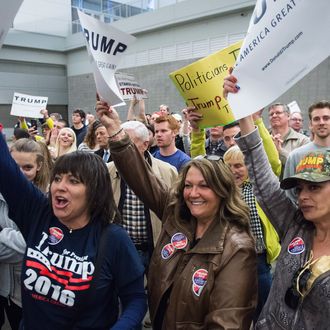
When Democrats hear that Pennsylvania may be in play this November, their natural tendency will be to say “yikes,” or wonder if it’s true that Donald Trump really is magic among white-working-class voters. After all, isn’t the Keystone State supposed to be reliably blue?
But as David Wasserman reminds us today at FiveThirtyEight, the map of “battleground states” and their ranking in the hierarchy of competitiveness can and does change all the time.
When most people think of battleground America, they think of Florida and Ohio, two of only three states (along with Nevada) that have voted for the winner of every presidential election since 1996. They tend not to think of Pennsylvania as a classic “swing state” — it has voted for the Democrat in every election since 1992, and it didn’t even crack the top 10 in 2012 campaign ad spending.
But in 2016, Pennsylvania could be the keystone of the Electoral College and the ultimate arbiter of whether Donald Trump or Hillary Clinton resides at 1600 Pennsylvania Avenue.
The reason has little or nothing to do with Donald Trump or Hillary Clinton. As Wasserman shows, Pennsylvania has been slowly but surely trending red in presidential elections for a long time, mainly because the western part of the state — sometimes called “Pennsyltucky” for its Appalachian characteristics — has been trending red a bit more decisively. Some of this trend reflects a fracking boom that has intensified the region’s attachment to fossil fuels, and some of it involves the conservative cultural tendencies of former Democrats.
Now, this is not to say that the states most recently thought of as critical battlegrounds have lost their importance. Wasserman thinks Trump will almost certainly have to carry Ohio and — this is the really tough one for him — Florida before Pennsylvania even becomes relevant. But Colorado and Virginia — big 2012 battlegrounds — are now trending blue so quickly that if Trump’s winning in those states he’s probably already won. Nor is Pennsylvania the only state thought of as blue that is trending red: So, too, are Michigan, Minnesota, and Wisconsin, though maybe not fast enough to be realistic short-term possibilities for ultimate-battleground status.
The old folks among us will recall that this shift in battlegrounds is hardly anything new. Not so very long ago California and Illinois — both staunchly blue in presidential elections today — were tossup states. So, too, was New York for many decades prior to the mid-1960s. Rapid demographic and/or ideological change can very decisively alter voting behavior. Virginia, for example, was the most regularly Republican state of the Old Confederacy until it suddenly became the most Democratic, and, to go back a ways, Bernie Sanders’s Vermont did not support a single Democratic nominee before 1964.
So, before long we may think of Pennsylvania as red like West Virginia, or of Georgia as blue like Virginia. I don’t know; both of these states have demographic and ideological features tugging against the larger statewide trend. But if Wasserman’s numbers are right, Pennsylvania television viewers are in for a nasty surprise this fall when the attack ads reach saturation level.






























